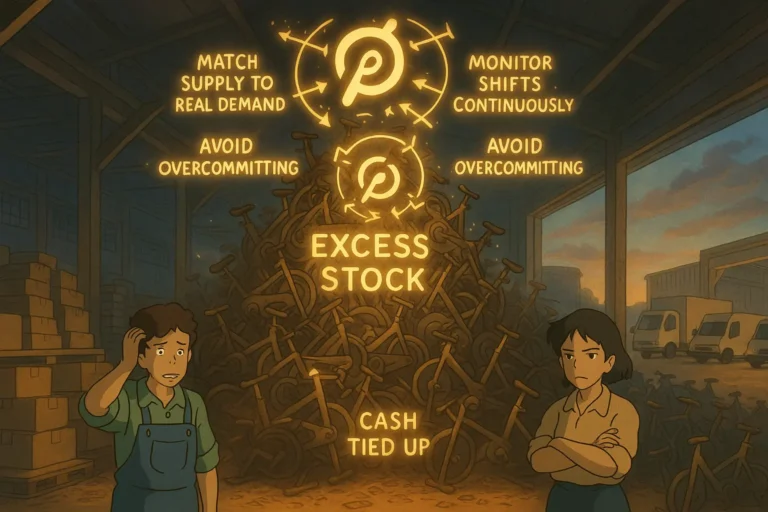
Optimizing safety stocks is an essential aspect of keeping the supply chain resilient.
Occasionally, supply chains fall behind due to operational mistakes or unforeseen events that cause disruptions throughout the supply chain.
One of the key ways businesses keep their supply chain moving is through the availability and maintenance of safety stocks.
Safety stock is the buffer between uncertainty and reality in supply chain management
What is Safety Stock?
Safety stock is a quantity of inventory set aside to act as a fallback option, even if a product is in the supply chain or business.
With safety stocks, supply chains enjoy a buffer that helps them navigate difficult situations without coming out at the end for the worst of it.
It gives them a controlling factor when all else seems to fail.
Benefits of Optimizing Your Safety Stock
Running out of stock causes any supply chain or business a lot of money, any way you look at it.
Whether from the angle of lost revenue or the additional expenses incurred from trying to fix it. A stockout doesn’t look well for any supply chain.
However, with a safety stock, supply chains can:
1. Withstand demand fluctuations
2. Curtail the impact of supply chain disruptions
3. Ensure customers are not disappointed
4. Make up for inaccurate demand forecasts
5. Maintain high efficiencies
Guides to Follow When Optimizing Your Safety Stocks
Optimizing your safety stocks reduces your exposure to them, allowing the safety stock to serve you longer.
You can achieve that with the following methods.
1. Improve Demand Forecast
Safety stock costs the supply chain money.
When not calculated properly, it could cost the supply chain a lot of money, proving counter-productive for resource management.
That is why you want to have just the right amount of safety stock that will not cost the supply chain too much and will more than pay for itself in the event of a disruption.
This is where demand forecasting becomes extremely important.
Remember that demand plays a huge role in the calculation of safety stock? It is a key factor in determining how much safety stock to have.
Too low demand and your safety stock will not serve its purpose. Too much demand and a safety stock become too expensive to maintain.
2. Reduce Supply Lead times
Lead times are critical pillars for any successful supply chain. They play a huge role in optimizing your safety stocks.
Longer lead times cause supply chain disruptions, impacting customer satisfaction.
Although safety stocks are supposed to serve as buffers, it is important to ensure that factors like lead times cannot be longer or extended beyond acceptable measures.
The ideal scenario for any supply chain is shorter lead times.
When allowed to extend, it puts the supply chain in a situation where it runs out of safety stock, which puts it face-to-face with the problem.
Supply chains should be optimized to avoid such issues, and they can do this by improving communication and supplier relationships.
3. Implement faster replenishment models
Part of the reason why supply chains tend to fall back on their safety stock is because of slow replenishment models.
The principle of replenishment is to ensure you have the right amount of stock at the right time, but sometimes, slow replenishment can impede this.
Slow replenishment can result from a number of factors, including poor communication, late reorder points, poor demand forecasting, and the wrong replenishment model.
With late reorder points, you may evaluate your sales and stock-keeping strategy to find reorder points that can work sufficiently for your supply chain.
On the other hand, when the replenishment model is wrong, it could be because of the business nature or the customer’s behaviour.
Whatever the situation, you will want to adjust your replenishment model to suit your supply chain process better.
4. Integrate Technology Solutions
Technology makes things easier in the modern world.
The same applies to the inventory management process and optimizing your safety stocks.
Calculating safety stocks can be quite cumbersome and prone to errors.
With tech solutions like ERP (Enterprise Resource Planning), you can easily track, automate, reorder, and monitor your stocks, which allows for more operational efficiency.
Tech solutions provide end-to-end visibility throughout the inventory management process, which helps limit the reliance on safety stock.
Tech solutions also allow you to easily analyze data on safety stocks for each product in your inventory, facilitating easy product segmentation.
Product segmentation is done to simplify switching between replenishment models.
5. Consider Industry Trends
Industry trends play a huge role in optimizing your safety stocks.
For example, the food industry has a relatively high demand but tends to have little to no safety stocks. This is because of the perishable nature of foods.
On the other hand, the fashion industry has a high demand but can keep safety stocks because they do not have to worry about perishability.
Clothes are also cheaper to store, greatly reducing the cost of holding inventory.
Industry trends play a huge role in the optimization of safety stocks.
FAQs on Optimizing Your Safety Stocks
Q1. What are some effective practices for maintaining safety stock in a global supply chain?
Collaboration with suppliers, distributors, and logistics partners is necessary for effective worldwide safety stock management.
Establishing reliable communication channels, exchanging demand forecasts, and using supply chain visibility tools can all contribute to ensuring the smooth flow of goods and reducing disruptions.
Q2. How frequently should safety stock levels be analyzed and modified?
Safety stock levels should be assessed on a regular basis, with the frequency depending on variables like lead time and demand unpredictability.
A quarterly or annual review is typical, although turbulent markets or industries may require more frequent revisions.
Q3. What are the possible dangers of depending too much on safety stock?
Increased carrying costs, an increased risk of obsolescence, and decreased cash flow might result from relying too much on safety stock.
To maximize supply chain effectiveness, finding the ideal balance between keeping enough safety stock on hand and reducing surplus inventory is crucial.
Conclusion
One thing is consistent in the constantly changing world of supply chain management: the critical function of safety stocks in mitigating disruptions and uncertainty.
As we’ve seen, these safety stocks serve as a safety net, enabling supply chains to weather the storms of unforeseen circumstances and operational difficulties.
However, optimizing safety stocks involves striking a careful balance between preparation and resource efficiency, not just having an excess.
Such optimization has numerous advantages, including preserving customer satisfaction, reducing revenue loss, and improving overall supply chain effectiveness.

Obinabo Tochukwu Tabansi is a supply chain digital writer (Content writer & Ghostwriter) helping professionals and business owners across Africa learn from real-world supply chain wins and setbacks and apply proven strategies to their own operations. He also crafts social content for logistics and supply chain companies, turning their solutions and insights into engaging posts that drive visibility and trust.








